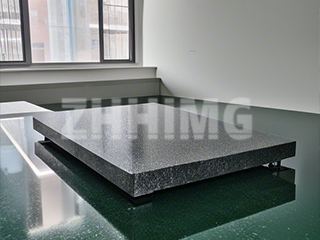Granite is widely used in precision engineering for manufacturing machine bases, metrology equipment, and structural components that demand excellent dimensional stability and durability. Known for its density, hardness, and corrosion resistance, granite offers several performance benefits. However, understanding how temperature changes affect granite’s thermal stability and overall performance is crucial in high-precision applications.
1. Thermal Stability of Granite
Thermal stability refers to a material’s ability to maintain its physical and mechanical properties under fluctuating or elevated temperatures. Granite is primarily composed of quartz, feldspar, and mica—minerals with low thermal expansion coefficients. This makes granite a naturally stable material, capable of maintaining its dimensional accuracy even when exposed to moderate temperature changes.
That said, even granite can experience subtle effects under thermal stress. At elevated temperatures, microscopic structural changes may occur within the mineral composition, potentially leading to the expansion of microcracks or slight surface wear. While such effects are negligible in most standard operating conditions, they can become significant in extreme environments.
2. How Temperature Variations Affect Granite Components
Temperature impacts granite machine components in two main ways: dimensional changes and mechanical property shifts.
-
Dimensional Stability:
As the ambient temperature fluctuates, granite undergoes minimal but measurable expansion or contraction. Although its coefficient of thermal expansion is lower than that of metals, prolonged exposure to sudden temperature shifts may still affect the accuracy of precision equipment, such as CNC bases or surface plates. For critical applications, it’s essential to maintain a stable thermal environment or implement temperature control systems to minimize these effects. -
Mechanical Performance:
High temperatures may slightly reduce the compressive strength and hardness of granite. In long-term applications, recurring thermal cycles could cause gradual degradation through the expansion and contraction of mineral grains, potentially forming microcracks. These issues may compromise the structural integrity and longevity of the component, especially in dynamic or load-bearing scenarios.
3. Enhancing Thermal Stability in Granite Structures
Several measures can help improve the thermal performance of granite machine components:
-
Material Selection:
Use granite varieties with proven low thermal expansion and uniform grain structure. Avoid materials with visible inclusions, cracks, or mineral inconsistencies. -
Design Optimization:
Mechanical components should be designed to reduce stress concentrations and prevent thermal deformation. Incorporating thermal break zones or insulation layers in the design can mitigate the effects of heat exposure. -
Environmental Temperature Control:
Maintaining a consistent ambient temperature through climate control systems or thermal insulation helps preserve measurement accuracy and prevents material fatigue. -
Routine Inspection and Maintenance:
For granite components exposed to high or variable temperatures, regular inspections are essential to detect early signs of wear or microcracking. Preventive maintenance helps prolong the service life and reliability of the equipment.
Conclusion
Granite machine components offer superior thermal stability compared to most metals and composites, making them ideal for high-precision industrial environments. However, like all materials, granite is still susceptible to performance variations under extreme or fluctuating temperatures. By understanding these effects and implementing proper design, material selection, and environmental controls, engineers can maximize the long-term stability and accuracy of granite structures.
Post time: Jul-24-2025

